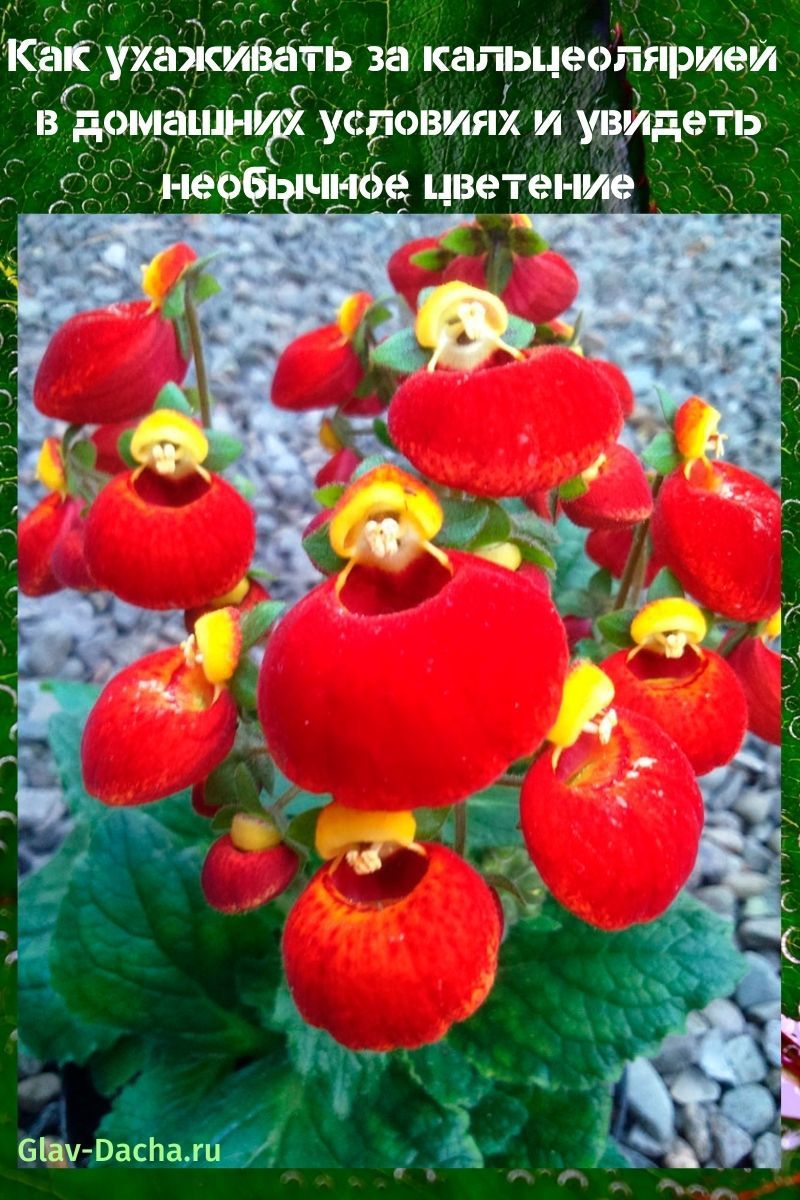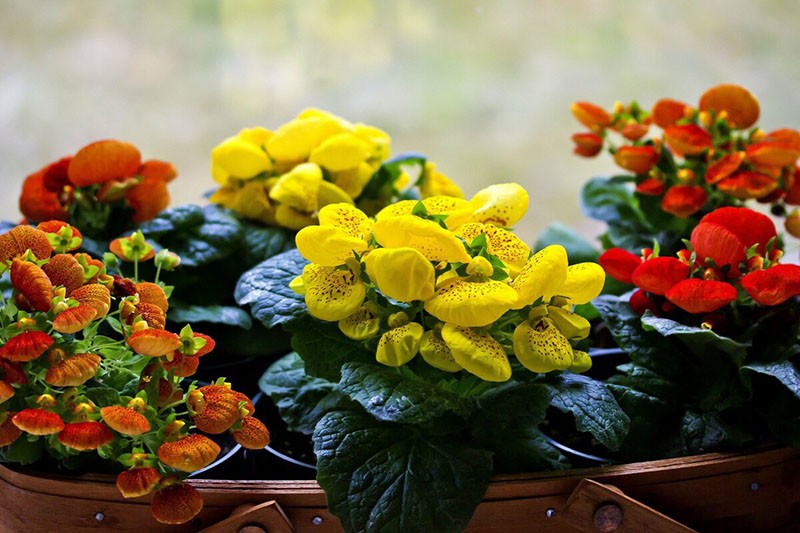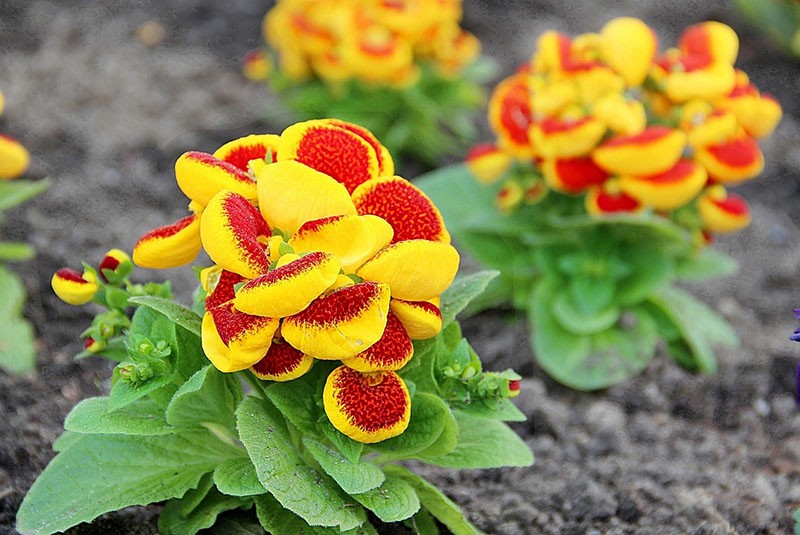How to care for calceolaria at home and see unusual blooms
 More recently, indoor plant lovers have replenished their collections with a surprisingly beautiful calceolaria plant. In order for the windowsills to be decorated with colorful flowers in the shape of shoes in early spring, it is important to know how to care for calceolaria at home. To do this, you must first study the features of the plant.
More recently, indoor plant lovers have replenished their collections with a surprisingly beautiful calceolaria plant. In order for the windowsills to be decorated with colorful flowers in the shape of shoes in early spring, it is important to know how to care for calceolaria at home. To do this, you must first study the features of the plant.
A close acquaintance with calceolaria

At home, perennial and annual species of calceolaria are grown. With good care, an annual can please one more year with its flowering.
Features of the plant:
- In nature, you can find shrub, semi-shrub and herbaceous calceolaria.
- The maximum height of erect, pubescent, branched stems is 55 cm.
- On the stems, opposite or in whorls, fluffy small leaves are located. The edges of the round leaves in the root zone are decorated with smoothed teeth. In the upper part of the stem, lanceolate leaves with reticular veins grow.
- The diameter of one inflorescence is 5-6 mm. Our eyes are delighted with purple, red, orange and yellow inflorescences. They are elegantly decorated with small bright red or pink dots.
- After flowering, small bolls with small seeds inside are formed.
- From mid-March, up to 55 beautiful bright flowers are revealed on one plant. In nature, the flowering of calceolaria ends in June. At home on the windowsill, hybrid varieties bloom until the end of summer.
Types and varieties of calceolaria for growing at home

Almost 300 species of calceolaria are found in nature. We will get acquainted with the most popular of them:
- Mexican calceolaria grows on wooded mountain slopes in Mexico. Flowers of bright yellow color bloom on thick, strong stems.

- Purple calceolaria is a perennial plant. The color of the flowers is saturated.

- Wrinkled calceolaria belongs to the largest representatives of the plant. The main color of the inflorescences of this type of calceolaria is yellow. New hybrid forms are distinguished by the presence of burgundy or brown dots on the colors.

- For indoor or outdoor cultivation, hybrid calceolaria is specially bred. It is she who unites all the best qualities of plants of different types. Varieties with flowers of different colors grow on the windowsills. When growing, it should be borne in mind that specimens with blots or stripes are much more demanding than varieties of monochromatic flowering.

- Calzellia crenellate is distinguished by bright yellow flowers with small splashes of brown.

- Delicate calceolaria belongs to dwarf varieties with bright yellow spotted shoes.

- Single-flowered calceolaria grows in South America on mountain slopes. Differs in large single flowers with a beautiful color.

- Calceolaria two-flowered in comparison with other species grows small.Its leaves are collected in a rosette at the very root. The plant produces only one erect stem, and up to two pairs of bright buds bloom on it.

How to care for calceolaria at home
 When choosing your favorite calceolaria specimen in a flower shop, you need to remember the capricious nature of the plant and prepare for careful caring for it. Calceolaria has special requirements for environmental humidity and temperature conditions.
When choosing your favorite calceolaria specimen in a flower shop, you need to remember the capricious nature of the plant and prepare for careful caring for it. Calceolaria has special requirements for environmental humidity and temperature conditions.
So that the calceolaria flowers you like do not fall off - place the pot with the purchased calceolaria in a cool room.
Long and lush flowering will delight you if the plant is in a room with a temperature of 12 to 15 ° C. It is necessary to adhere to this range both in summer and winter. In case of violation of the temperature regime and with an increase in the indicator of the thermometer to +20 ° C, calceolaria in a short time becomes completely unattractive.
Watering for calceolaria
 Constant waterlogging of the soil or short-term drought in a pot with calceolaria leads to the development of a fungus and can cause the death of the plant. The soil should be moistened regularly with a moderate amount of settled water. As soon as the top layer dries up a little and becomes loose, the flower must be watered. Any liquid that has seeped onto the pallet must be drained.
Constant waterlogging of the soil or short-term drought in a pot with calceolaria leads to the development of a fungus and can cause the death of the plant. The soil should be moistened regularly with a moderate amount of settled water. As soon as the top layer dries up a little and becomes loose, the flower must be watered. Any liquid that has seeped onto the pallet must be drained.
As soon as calceolaria fades, watering is carried out 1-2 times a month.
Calceolaria watering rules:
- abundant watering;
- the use of water previously settled at room temperature;
- give preference to rain or melt water;
- after watering, remove excess liquid from the pan;
- do not allow water to enter the fluffy leaves;
- do not allow the soil to dry out in the pot.
 Calceolaria should be fed regularly (every 2 weeks) with liquid mineral complexes to lay buds and lush flowering. If you plant calceolaria in a pot with nutritious soil, you do not need to use fertilizers for the first 2-3 weeks. Also, plants do not need feeding in autumn and winter.
Calceolaria should be fed regularly (every 2 weeks) with liquid mineral complexes to lay buds and lush flowering. If you plant calceolaria in a pot with nutritious soil, you do not need to use fertilizers for the first 2-3 weeks. Also, plants do not need feeding in autumn and winter.
Air humidity
 Calceolaria has a special requirement for indoor air humidity, but reacts poorly to spraying. Even a few drops of water falling on the foliage of the plant lead to the appearance of brown painful spots, which can lead to the death of the indoor flower.
Calceolaria has a special requirement for indoor air humidity, but reacts poorly to spraying. Even a few drops of water falling on the foliage of the plant lead to the appearance of brown painful spots, which can lead to the death of the indoor flower.
Comfortable conditions for keeping calceolaria are air in a room with high humidity.
For this:
- Place the pot with the plant in a pallet with wet river pebbles or expanded clay;
- spray the air around the calceolaria with warm water, avoiding moisture on the plant itself.
To increase the air humidity to the required parameters, expanded clay is used. To do this, put it in a wide container and fill it with a little water. A pot with calceolaria is placed on top. Periodically check how much the liquid has evaporated and add it if necessary.
If the calceolaria pot is placed in pots, then its size is chosen slightly larger than the size of the pot. Moss is placed in the space between the walls and moistened. In this case, the moisture content of the moss must be constantly maintained.
Lighting mode
 To enjoy the beautiful flowering of a calceolaria plant, it is necessary to provide bright diffused light. From direct sunlight on the flowers, burn spots are formed on the delicate leaves. The affected leaves quickly wither and begin to fall off.
To enjoy the beautiful flowering of a calceolaria plant, it is necessary to provide bright diffused light. From direct sunlight on the flowers, burn spots are formed on the delicate leaves. The affected leaves quickly wither and begin to fall off.
The most comfortable place in an apartment or house for a calceolaria will be the windowsills on the north side.
As a last resort, you can place flowerpots on the windows from the northwest or east side. At the same time, light curtains or blinds must be used to protect plants from the sun. Calceolaria pots are placed in a balcony protected from drafts, wind and bright rays of the sun in summer.
 In insufficient light, plants stop developing and plant buds. The leaves become pale and not very attractive in appearance. If it is not possible to provide calceolaria with sufficient natural light, it is necessary to make up for the deficiency by installing additionally conventional or phytolamps.
In insufficient light, plants stop developing and plant buds. The leaves become pale and not very attractive in appearance. If it is not possible to provide calceolaria with sufficient natural light, it is necessary to make up for the deficiency by installing additionally conventional or phytolamps.
Features of calceolaria transplant
 Store-bought calceolaria in a pot after the end of the adaptation period must be transplanted into fresh nutrient soil. Garden centers use small shipping pots with special nutrient soil to grow flowers. This substrate is enough for a certain period and the plant cannot be left in it for a long time.
Store-bought calceolaria in a pot after the end of the adaptation period must be transplanted into fresh nutrient soil. Garden centers use small shipping pots with special nutrient soil to grow flowers. This substrate is enough for a certain period and the plant cannot be left in it for a long time.
Calceolaria transplant rules:
- Use a disinfected, larger pot with small holes in the bottom.
- Use expanded clay or other suitable material as drainage material.
- Pour a small amount of nutritious soil onto the drain.
- Gently remove the plant from the purchased pot without shaking off the earthen lump from the roots. Move the shrub to a new pot while maintaining the integrity of the root system.
- Shake the pot occasionally and fill it with new soil. Seal to fill all voids. Close the roots carefully with fresh composition.
- Water the plant abundantly with warm, settled water. The earth ball in the pot must be completely saturated with moisture. Drain excess water from the pan.
Purchased soil is ready to use. Self-made soil must be disinfected before use.
How to care for calceolaria at home after flowering
 At home, calceolaria is grown as a biennial plant. To see the repeated flowering of calceolaria, it is necessary to keep the plant intact and healthy until the next season.
At home, calceolaria is grown as a biennial plant. To see the repeated flowering of calceolaria, it is necessary to keep the plant intact and healthy until the next season.
Basic Rules:
- After flowering, carefully cut off all the shoots.
- Hide the pot with the root system in a cool dark place (10-12 ° C) and leave it there for 45-60 days.
- Make sure that the soil in the pot does not dry out by periodically pouring warm water over it.
- As soon as the first shoots begin to appear from the soil, the pot must be put back on the windowsill in a cool room.
- It's time to resume watering and fertilizing.
 After a safely transferred dormant period, the plant will actively grow and lay the first buds. The first shoots usually grow weakened and elongated. Therefore, it is best to remove the weakest shoots, and cut the stronger ones, leaving only 1/3 of their length. Such actions will help preserve the decorative effect of the plant. But there will be no such abundant flowering as the first time.
After a safely transferred dormant period, the plant will actively grow and lay the first buds. The first shoots usually grow weakened and elongated. Therefore, it is best to remove the weakest shoots, and cut the stronger ones, leaving only 1/3 of their length. Such actions will help preserve the decorative effect of the plant. But there will be no such abundant flowering as the first time.
Growing an indoor calceolaria flower from seeds
 If you want to admire the lush unusual flowering of different varieties of calceolaria on your windowsills every year, then it is best to learn how to grow it from seeds yourself. It will take more than six months to grow a lush bush from small seeds. These terms must be taken into account when choosing the time of sowing seeds. For young specimens to bloom in spring, seeds must be sown in early summer. If seeds are planted in March, calceolaria will open its buds only in autumn.
If you want to admire the lush unusual flowering of different varieties of calceolaria on your windowsills every year, then it is best to learn how to grow it from seeds yourself. It will take more than six months to grow a lush bush from small seeds. These terms must be taken into account when choosing the time of sowing seeds. For young specimens to bloom in spring, seeds must be sown in early summer. If seeds are planted in March, calceolaria will open its buds only in autumn.
Stages of growing calceolaria from seeds:
- Fill container with nutrient medium. Moisten it and sow seeds on top. You do not need to sprinkle them with soil.

- Cover the containers with plastic foil and place them in a cool room on a windowsill.
- Spray periodically to sprout faster. In two weeks the first shoots will appear.
- In 2-3 weeks after the first shoots, make the first pick. Water the plants carefully and periodically air the mini-greenhouses to avoid condensation.
- 2 months after the first transplant, transplant the seedlings into separate small pots. Pinch immediately to form lush bushes. It is necessary to leave 2-3 pairs of leaves.
- As soon as young calceolaria bushes are strong, they need to be transplanted into larger pots with good nutrient soil of higher density.

- Reduce the temperature of the content so that the plants will bud for a lush bloom.

Subject to all the points of growing a calceolaria indoor flower, the plant will thank you with stunning beautiful flowering.